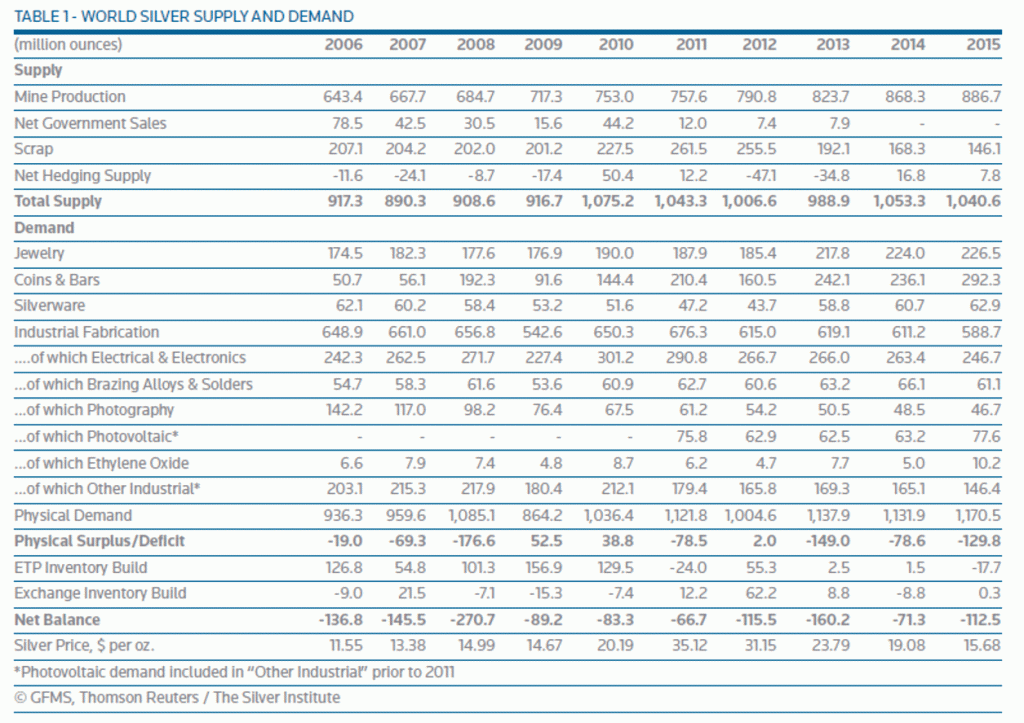On Silver and Money
Silver is thought to have been first used as money in Mesopotamia around 3,000BC. The silver was initially in the form of rings worn as jewelry that also functioned as currency. Coins were subsequently minted using the sexagesimal system (this system, based upon 60, is still used today to measure time, angles and co-ordinates) developed by the Sumerians in southern Mesopotamia.
The lowest denomination was the shekel, around 11 grams, then the mina which was 60 shekels, and the talent which was 60 minas. Silver coinage was used more or less continuously until about 100 years ago. Perhaps the most famous coins have been the Roman denarius and the Spanish dollar, worth eight reales (“pieces of eight”).
Although not a currency today, silver still represents a store of value for many. However, unlike gold, coins and bars are only a small part of the total demand for silver. As can be seen in the table below bars and coins are only 25% of total demand. However, investment in coins and bars has been growing strongly, from 50Moz in 2006 to 292Moz in 2015.
Silver is more useful than gold as money because of its much lower unit value. In Babylon, the most famous city of Mesopotamia, workers earned about 2 grams of silver a day. In ancient Greece workers earned about 4 grams of silver per day, similar to workers in ancient Rome. Two grams of silver was a day’s wage in medieval England. This shows a remarkable consistency over thousands of years.
In 2016 the minimum wage in Australia was $672/week. At present the London silver fix is AUD25/oz, or AUD0.79/g. the minimum wage is therefore equivalent to 835 grams of silver per week. This compares with a wage of 14 to 30 grams per week for much of history.
However, this is not a fair comparison as most workers around the world earn much less than that. A couple of years back the International Labour Organisation (“ILO”) estimated that, in terms of purchasing power parity, the world’s average wage was USD370/month. Still a lot of silver.
In summary, silver has lost most of its purchasing power over the past 100 to 200 years. This is no doubt a result of the prevalence of fiat currency worldwide and the resulting currency debasement. For silver (and gold) to make a return as currency, there would have to be a failure of fiat currency.
The first use of paper (fiat) currency was around 800AD in China. Its use was short lived as numerous merchants refused to accept it. It also, of course, resulted in hyperinflation.
Some argue that the collapse of present day fiat currency has already begun. I doubt it. We would first have to see widespread rejection of the dollar, pound, euro etc. and people trading in alternative currencies such as silver. Should this happen you can guarantee governments would ban the private ownership of gold and silver.
So, while ownership of silver is sensible, it must be absolutely safe from theft, even bank safe deposit boxes may not be safe at all.
More on silver later.
Last year the Silver Institute published the “2016 World Silver Survey”. It is an excellent review of the global silver market. Read it here – WorldSilverSurvey2016 – it’s a must. I would like to thank The Silver Institute and the GFMS (previously Gold Fields Mineral Services) team at Thomson Reuters for permission to reproduce charts/tables from the publication.

